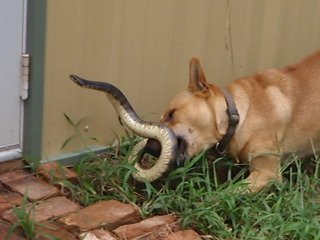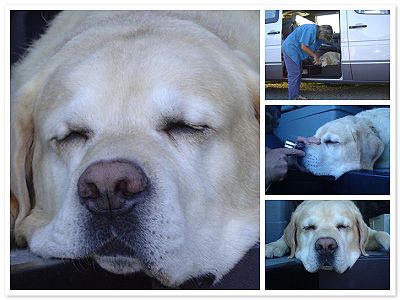
Most snakes will try to avoid contact, but pets can be curious and persistent. When they see something so tempting moving, they are bound to poke at it. While we don’t often see snakes in the city, pets can encounter them there as well, sometimes in local parks.
Snakes hibernate or are inactive during winter months. Spring and summer are the seasons when they are out and about.
In the U.S. most bites come from water moccasins and copperheads found in the Eastern U.S. south to Texas and rattlesnakes throughout the U.S., mainly in the South and Southwest. Depending on what part of the world you live in there can be different types of venomous snakes. Animal control in your area can tell you which snakes to beware of.
If your pet is bitten by a snake, keep him/her quiet and as immobile as possible. If you can, identify the snake or at least have a description of what it looks like. Call your vet or emergency animal service and get help as soon as possible.
Snakebites usually occur around the head, neck and limbs of a pet. Body bites can be more serious since they are closer to the heart. The type of snake, where the bite is located and time elapsed before treatment will determine the outcome.
Symptoms can be bruising, bleeding, swelling, shaking or trembling, vomiting, weakness, collapse. Check for puncture wounds.
Treatment consists of intravenous fluids, antibiotics, antihistamines to minimize risk of an allergic reaction, oxygen if necessary. Your vet will determine whether an injection of anti-venom should be given. It becomes less effective if given much later. Your vet will keep your pet under observation for at least a day. Tests will be performed often to check for bleeding or organ damage. The bite wound area will be checked regularly.
Although snakebites are quite painful, NSAIDs are usually not given for the first 24 hours due to their anticoagulant effect. Steroids many not be given as some studies indicate they may increase the severity of the bite.
It’s important that when your pet is at home, you continue observation to watch for any signs of distress. Kidney damage can take 24-72 hours to develop.
If the snake is not poisonous, pain and swelling can be minimal.
When out walking or hiking, keep your pet away from unknown grassy areas or rocky formations. If you see a snake on your property, contact animal control to remove it. Don’t attempt it yourself.
When your pet is outdoors and shows an interest in something you can’t see, it’s a good idea to check. Remember to be alert when on a trail for your safety and your pet’s.
There are snake aversion classes for dogs that enlist the use very young rattlesnakes or those that have been defanged along with shock collars for the dogs when they get too near the snake. While I don’t support this kind of training, in cases where the dog is persistent (too dumb to know the danger), it might be the only way to ensure saving its life.



